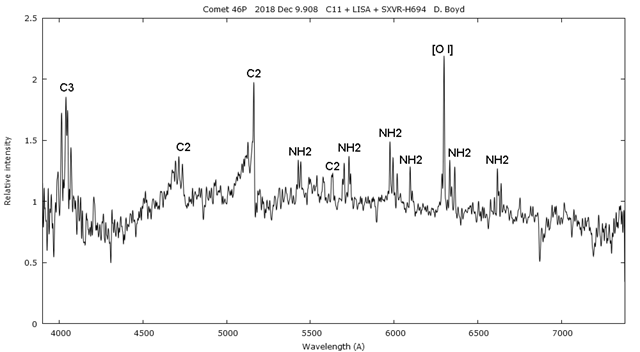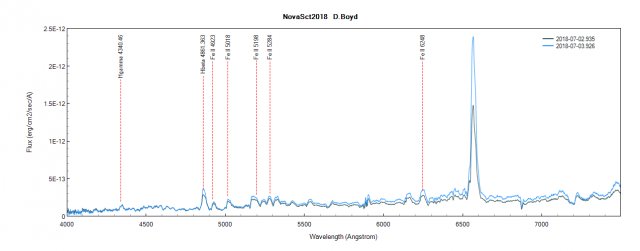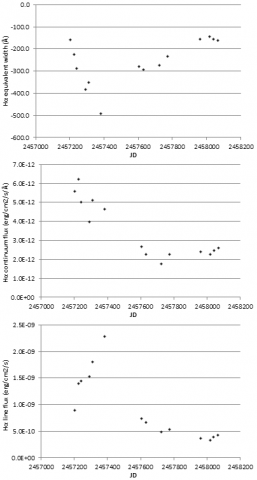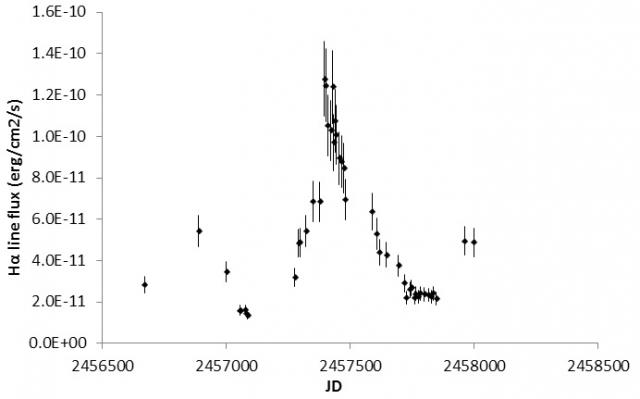Forum Replies Created
-
AuthorPosts
-
 David BoydParticipant
David BoydParticipantHere is a spectrum of comet 46P taken last night Dec 9.908 with a LISA spectrograph on a C11. Total exposure time was 3000 sec. The spectrum was integrated in the Y direction over 27 arcsec on the sky which is approximately 3x the FWHM of the bright central region of the spectrum. Sky subtraction regions were approx 3 arcmin away for the comet so although they will contain some light from the coma this is relatively faint at that distance and so should not significantly reduce the intensity of the central spectrum.

I have tentatively identified the most prominent lines using the table in Brown et al., Astronomical Journal, 112, 1197-1202 (1996). Although there is also an emission line from NH2 at 6300A, most references appear to attribute the very bright line at that wavelength to [O I].David
 David BoydParticipant
David BoydParticipantT Tauri stars are young dynamic objects experiencing accretion from a circumstellar disc. This is a stochastic process so changes over time are normal. An inverse P-Cygni profile is a signature of infalling material which is part of the accretion process. However accretion is not continuous and tends to happen irregularly so it is not really surprising if the inverse P-Cygni profiles come and go in the spectrum. It would be interesting to take further spectra periodically to see how they change. Changes in accretion may also manifest themselves as changes in the magnitude of the star as it brightens and then fades.
David
 David BoydParticipant
David BoydParticipantI use Astroart 5 which has a slit guiding facility. You place a cross over the image of the slit in the guide camera window and the software will then keep the star centred on that point. It seems to understand that the image of a star in the slit has two lobes above and below the slit and manages to keep it reasonably stable within the slit, subject of course to the vagaries of seeing. I have used it for years and am very happy with it.
David
 David BoydParticipant
David BoydParticipantHi Robin,
The first really usable line in my Ar-Ne lamp spectrum is at 4158.590A. Below that the lines are either blended or too faint unless I overexpose the red end. Including the 3946.097A line gives a considerably worse fit at the blue end. So the accuracy of my wavelength calibration drops off below 4000A and I normally don’t report my spectra below 3900A.
The ISIS wavelength fitting report issue is curious. Here is a report I got recently.

The lambda values listed are all exactly the values I provide in my .lst file. Maybe it depends on the spectral calibration mode you use?
David
 David BoydParticipant
David BoydParticipantMy understanding is that the mixed method (lamp + Balmer lines) was used in ISIS to compensate for the original Ne-only lamp bulbs only having usable lines at the red end. When Shelyak introduced the replacement Ar-Ne bulbs, I was told that method was redundant and I should just use the lamp lines. In my LISA the Ar-Ne bulb produces sufficient lines across the whole spectrum to use for calibration without needing a stellar spectrum. I always had problems getting a good result with the mixed method and found using just the Ar-Ne lines worked much better.
I probably missed it somewhere in the earlier discussion whether John’s lamp has the Ar-Ne bulb. Some of these bulbs can deteriorate over time so it may be worth asking Francois Cochard at Shelyak if the emission line spectrum you get from the Alpy calibration module is what he expects to see. I’ve found Francois very willing to help resolve problems like that.
One small point on an earlier posting by Robin. Robin said “I see the wavelengths I posted (and listed by ISIS in the reports) are the values calculated from the fit, not the true values”. In my experience, the lambda values which ISIS lists in the report are the true wavelength values you give it for the lines. The dlambda values are the corrections it has applied to these values to get the best fit.
David
 David BoydParticipant
David BoydParticipantI am curious about the wavelengths which both John (implicitly in the ISIS listings) and Robin give for their calibration lamps. These are different from the standard Ar and Ne wavelengths given by NIST, for example here https://physics.nist.gov/PhysRefData/ASD/lines_form.html
If you look at the discrepancies which ISIS lists in John’s calibration fit, these appear to be almost exactly what is needed to bring the lines into agreement with the NIST values.
I have the Shelyak Ar-Ne lamp in my LISA and use a .lst file in ISIS which contains the NIST wavelength values. This routinely gives me a 4th order polynomial fit with rms residual less than 0.1.
David
 David BoydParticipant
David BoydParticipantTo mitigate this problem, if I am recording the spectrum of a target at low altitude (close to 30 deg) I will look for a reference star as close as possible in altitude to my target and then record spectra of the reference star both before and after the set of spectra of the target. I compute response profiles from both sets of reference star spectra and take the mean of these to use in correcting the target spectrum. Although not perfect, this is better than choosing just one of the response profiles. It is instructive to see how much the response profile can change over an hour for a star at low altitude.
David
 David BoydParticipant
David BoydParticipantI confirm Kevin’s recipe for getting gnuplot to work with ISIS. I run v4.6.6 on Win10. There is indeed a pgnuplot.exe in that release. My only difference is that I don’t have ‘full control’ ticked in the folder permissions and it still seems to work OK.
David
 David BoydParticipant
David BoydParticipantThe spectrum has changed a lot from June 30 to July 2 and then relatively little from July 2 to July 3. H-alpha emission is growing.
David

 David BoydParticipant
David BoydParticipantIn my view there are two aspects to this we should be considering:
a) does the proposed activity have a clearly defined observing programme and what are its goals and timescales?
b) where are the skills and experience most likely to be found to pursue that programme and achieve these goals?
At the moment, the answer to the second question is probably within the Variable Star Section. These observers are used to measuring the faint, low amplitude signals required, using a range of filters and processing the data. It would therefore seem logical to consider launching the new activity within that body of observers and attempting to build a sufficient level of interest and activity that the goals can be seen to be achievable and the timescales realistic. Once a firm base of activity has been established, useful results are being achieved and a long term programme looks viable, then is the time to consider forming a new section or group within the BAA.
Regards,
David
 David BoydParticipant
David BoydParticipantThanks Andy. Good call Robin.
David
 David BoydParticipant
David BoydParticipantThe full programme of talks at the BAA/AAVSO joint meeting on variable stars at Warwick University in July is now available at https://britastro.org/summer2018.
There is still an opportunity to present a poster at the meeting by contacting Roger Pickard at roger.pickard@sky.com.
David
 David BoydParticipant2017 was my worst year for clear nights since 2006. I managed to record useful photometry and/or spectroscopy on 102 out of the 273 nights when I was available to observe. Assuming this is representative of the whole year, observing should have been possible on 37.4% of nights. In 2016, the equivalent figure was 45.3%. The best months in 2017 were March, August and November and the worst February and September.During 2017 I measured 25427 photometry images and recorded 2333 spectra.Best wishes for clearer skies in 2018!David
David BoydParticipant2017 was my worst year for clear nights since 2006. I managed to record useful photometry and/or spectroscopy on 102 out of the 273 nights when I was available to observe. Assuming this is representative of the whole year, observing should have been possible on 37.4% of nights. In 2016, the equivalent figure was 45.3%. The best months in 2017 were March, August and November and the worst February and September.During 2017 I measured 25427 photometry images and recorded 2333 spectra.Best wishes for clearer skies in 2018!David David BoydParticipant
David BoydParticipantA quick calculation using the spec of the QHY5L II camera from their website with a 225mm FL scope indicates a field of view of around one degree. This is probably larger than the field you see in the Alpy guider camera but still quite small if your mount’s pointing is not very accurate. A shorter FL camera lens would give a wider field in proportion to the ratio of their FLs. You could attach a camera lens to the QHY camera with an appropriate adaptor taking account of the distance of the CCD chip behind the front plate of the camera so the lens focuses on the CCD. I don’t know about webcams these days. I imagine the problem would be finding camera driver software compatible with the other software you are using.
Best wishes,
David
 David BoydParticipant
David BoydParticipantHi John,
This is a common problem unless you happen to have a mount capable of very accurate pointing. You can either use your finder scope visually, or more conveniently, attach a small CCD or CMOS camera fitted with a normal camera lens on top of your scope so you can see the wide angle field to which the telescope is pointing on the computer screen. Within this you should be able to see your intended target. By working out where the small field you see in the Alpy guide camera is within the wider field from the piggy-back camera, you can work out how to adjust your mount’s pointing to bring the target into the Alpy guider field.
David
 David BoydParticipant
David BoydParticipantFollowing on from Robin’s comments above, the plots below show how the EW, continuum level and flux of the H-alpha emission line of AG Peg have varied over the past couple of years. Clearly what the continuum is doing has a big influence on how you interpret changes in the EW as an indication of how the line flux is varying.
David

 David BoydParticipant
David BoydParticipantHi Robin,
Rotating the camera was one of the many things I tried but the results were inconclusive.
SX cameras have three sets of push-pull screws round the front of the camera which enable the front face of the camera body to be made exactly parallel to the CCD surface. When Terry reassembles the camera, one of the checks he makes is to adjust this using a collimating system which reflects light off the chip surface.
David
 David BoydParticipant
David BoydParticipantHi Paul,
Terry showed me the chip and I could not detect the presence of the oil visually. He said one effect it had was to change the colour of the surrounding chip package slightly. I think you would need the experience of what that subtle difference between clean and contaminated chips looked like to pick it up.
David
 David BoydParticipant
David BoydParticipantHi Hugh,
There is a more recent paper on EG And by Kenyon & Garcia at http://iopscience.iop.org/article/10.3847/0004-6256/152/1/1/pdf.
Regards,
David
 David BoydParticipant
David BoydParticipantIt is also worth keeping an eye on the H-alpha emission line in AX Per which shows strong orbital modulation, as do all the Balmer lines. The following plot shows my flux measurements over the last two orbital cycles. Coverage of the first cycle was patchy. The phase is currently about 0.4 and the flux is now rising. It will be interesting to see if the peak is as high as last cycle.
Regards,
David

-
AuthorPosts
